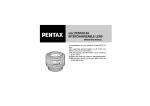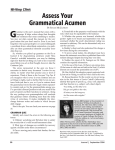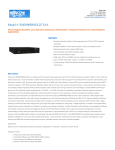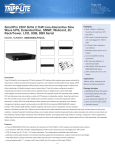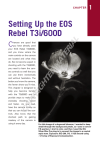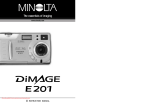Download Canon HF S21 Camcorder User Manual
Transcript
FA lens-Cover.indd 1
smc PENTAX-FA
INTERCHANGEABLE LENS
OPERATING MANUAL
15 8 2
10 3
50
8
A 22 16 11
.4
5.6 4
2.81
2008/09/26 15:39:18
Foreward
Thank you for purchasing the smc PENTAX lens.
This operating manual applies to all of the smc PENTAX FA and FA
J lenses.
Please also read your camera's operating manual.
* In this manual, the "smc PENTAX - FA lens" is referred to as "FA
lens" and the "smc PENTAX - FA J lens" as the "FA J lens".
* Illustrations shown herein may differ from the actual appearance.
* PENTAX and smc PENTAX are trademarks of HOYA CORPORATION.
FA lens-Cover.indd 2
2008/09/26 15:39:19
USING YOUR LENS SAFETY
1
Although we have carefully designed these lenses for safe
operation, please pay special attention to items marked with
the following symbols when using this product.
FA lens-Body.indd 1
WARNING
This symbol indicates precautions that if not
followed, could result in serious injury to the
user.
CAUTION
This symbol indicates precautions that if not
followed, could result in minor or medium
injury to the user or damage to the equipment.
2008/09/30 17:02:34
FA lens-Body.indd 2
2
WARNING
• Never look at the sun
through the lens or
camera. Serious damage to
the retina, or total loss of
eyesight may occur.
• Wrapping the strap around
your neck is dangerous.
Make sure that small
children do not get the
strap caught around their
neck. (A strap is supplied
only with some large types
of lenses)
CAUTION
• Do not leave the lens in
direct sunlight without lens
caps. Sunrays passing
through the lens will be
intensified, and should
they focus on flammable
materials, fire may occur.
2008/09/30 17:02:34
PRECAUTIONS AND LENS MAINTENANCE
3
1. Storage and mildew prevention
• Take the lens out of the protective case or camera bag, and store it in a dry,
well-ventilated place.
• Avoid storing the lens in a poorly ventilated location such as a closet, wardrobe, drawer, vehicle, or where insect repellent or medicine is kept.
• Avoid storing the lens in areas of high temperature and humidity, where there
is a risk of mildew growth.
Store the lens with a desiccant in a dry cabinet, airtight container, or plastic
bag. (Leaving a saturated desiccant in the storage container can cause damage to the lens. Be sure to read the instructions that come with the desiccant
before use.)
2. The lens is not waterproof. When using the lens in a rain or mist, be careful
not to allow it to get wet.
3. Never use any organic solvent such as thinner, alcohol, or benzine, etc. to
remove dust on the lens.
4. The lens is a precise optical instrument. Be careful not to let it fall, or subject
it to strong shocks or pressure. Use a cushion or similar pad to protect the
lens from the vibrations of motorcycles or other vehicles, boats, etc.
FA lens-Body.indd 3
2008/09/30 17:02:34
4
5. Avoid subjecting the lens to rapid changes in temperature, otherwise condensation may occur on both the inside and the outside of the lens. Put the
lens in a plastic bag or camera bag, and take it out after the lens has reached
ambient temperature.
6. When the lens is not attached to the camera body, attach both the provided
lens cap and lens mount cap to protect it from dust.
7. Do not leave the camera with the lens cap off attached to a tripod or other
rigid camera support. The inner parts of the camera can be damaged by
direct sunlight.
8. Have the lens inspected by a dealer every one or two years to maintain its
high performance.
FA lens-Body.indd 4
2008/09/30 17:02:35
CONTENTS
5
PRECAUTIONS AND LENS MAINTENANCE …………………………… 3
About the smc PENTAX-FA/FA J Lens…………………………………… 7
• About the zoom ring ………………………………………………………… 9
Changing the Lens…………………………………………………………… 10
Finger Point on Limited Lenses …………………………………………… 11
Lens Cap ……………………………………………………………………… 11
Focusing ……………………………………………………………………… 12
• Autofocusing ………………………………………………………………… 12
• Manual focusing …………………………………………………………… 12
• FA lenses …………………………………………………………………… 13
• Setting autofocus …………………………………………………………… 13
• Setting manual focus ……………………………………………………… 13
Setting the Aperture [A (Auto) Lock Switching] ……………………… 15
• About the Zoom Lens Aperture …………………………………………… 16
• Apertures and Click Stops ………………………………………………… 17
Using the Infrared Index …………………………………………………… 18
• Zoom Lens Infrared Index ………………………………………………… 19
FA lens-Body.indd 5
2008/09/30 17:02:35
6
Lens Hood …………………………………………………………………… 20
• Note: ………………………………………………………………………… 20
• Compatible Lens Hoods …………………………………………………… 21
• Attaching a Round Lens Hood …………………………………………… 22
• Attaching a Square Lens Hood …………………………………………… 23
• Using the Built-in Lens Hood ……………………………………………… 24
• PL Filter Window …………………………………………………………… 25
Tripod Mount ………………………………………………………………… 27
Filters…………………………………………………………………………… 28
• Filter Cautions ……………………………………………………………… 28
• Filter Sizes …………………………………………………………………… 28
• Note: Using a Circular Polarizing Filter …………………………………… 29
• Note: Attaching a Specialized Hood ……………………………………… 29
Cautions When Using Flash ……………………………………………… 30
• Compatibility with Built-in Flash …………………………………………… 31
Lens Case……………………………………………………………………… 32
• Lens Case Compatibility Table …………………………………………… 32
Main Specifications ………………………………………………………… 34
STATEMENT OF FCC COMPLIANCE …………………………………… 36
FA lens-Body.indd 6
2008/09/30 17:02:35
About the smc PENTAX-FA/FA J Lens
7
[Single Focal Length Lens]
FA lens-Body.indd 7
Focusing ring
Front-ring threads
Distance scale
15 8 2
10 3
50
4
8 5.6
A 22 16 11
.4
2.81
Aperture ring
Depth-of-field scale
Aperture A-lock button
2008/09/30 17:02:35
8
[Zoom Lens]
Focusing ring
Distance scale
Aperture index
{long focal length}
Aperture A-lock
button
Zoom ring
Aperture ring (note)
Aperture index
{short focal length}
Note: The following lenses do not have an aperture ring: FA J 18-35mm
f/4-5.6AL, FA J 28-80mm f/3.5-5.6AL, and FA J 75- 300mm f/4.5-5.8AL.
The aperture is controlled at the A [Auto] setting. Therefore, the lens is not
compatible with cameras and accessories which are not compatible with
the A setting.
FA lens-Body.indd 8
2008/09/30 17:02:35
9
A zoom lens has two rings: The
focusing ring at the front of the lens
and the zoom ring behind it. Turn the
zoom ring to obtain the desired angle
of view (focal distance).
* Whenever you turn the zoom ring
to change the angle of view (focal
distance), the focus may also
change slightly. First turn the zoom
ring, then focus.
FA lens-Body.indd 9
About the zoom ring
Turning the zoom ring to the right
gets a [Telephoto] effect, making the
subject look larger. Turning it to the
left gets a [Wide angle] effect, covering a wider area.
2008/09/30 17:02:35
10
Changing the Lens
1. Align the mount index red dots
on the camera body and lens and
attach the lens. Turn the lens clockwise until it locks in place.
2. To detach the lens, hold down the
camera's lens unlock button, then
turn the lens counterclockwise.
* When attaching a lens, do not press the camera's lens unlock button. Doing
so causes improper lens attachment.
* After attaching a lens, turn the lens counterclockwise slightly to make sure the
lens is locked in place.
FA lens-Body.indd 10
2008/09/30 17:02:35
Finger Point on Limited Lenses
Lens Cap
You can easily attach a Limited lens
by aligning the finger point on the
lens with the camera's lens unlock
button.
Limited lenses
FA 31mm f/1.8AL Limited
FA 43mm f/1.9 Limited
FA 77mm f/1.8 Limited
To remove the lens cap, squeeze the
tabs as shown in the illustration.
FA lens-Body.indd 11
11
* When not using a lens, be sure to
attach the lens cap.
* For the FA 43mm f/1.9 Limited
lens, attach the lens cap to the
hood. The lens cap cannot be
attached directly to the front of the
lens.
2008/09/30 17:02:35
12
Focusing
15
3
10
8 6
2 1.5
ft
m
50
A
To switch between autofocusing and
manual focusing, use the camera's
focus mode lever. For details, refer to
your camera's instruction manual.
* For FA lenses, see page 13.
* For non-autofocus cameras, use
manual focusing.
FA lens-Body.indd 12
22 16 11 8 5.
64 2
821
4
Autofocusing
Press the shutter button halfway to
autofocus.
* During autofocusing, the focusing
ring rotates so do not touch it.
Manual focusing
Turn the focusing ring as shown in
the illustration.
2008/09/30 17:02:36
13
Setting autofocus
Push the focusing ring forward until
you can see AUTO FOCUS.
* When the lens is set for autofocus,
the focusing ring locks.
FA lenses
With FA lenses, shift the focusing ring forward or back to switch
between autofocus and manual
focus.
FA lens-Body.indd 13
Setting manual focus
Pull the focusing ring until AUTO
FOCUS is hidden. Turn the focusing
ring to focus manually.
2008/09/30 17:02:36
14
* If your camera has a KAF2 mount,
you can still switch between autofocus and manual focus with the
lens focusing ring even when the
camera has been set to autofocus.
* If you have a camera (such as the
SF-series) having a KAF mount, set
both the camera and lens focus
mode switch to the same setting. If
the camera is set to autofocus [AF
single] and the lens is set to manual focus, you cannot take a picture
until the camera's focus indicator
lights.
* If you use a camera which does not
have autofocus, focus manually.
FA lens-Body.indd 14
* The telephoto lens' focusing ring
stops turning at slightly past the ∞
infinity symbol. This is because,
the point of focus changes depending on the temperature, and sometimes the focus is achieved beyond
the ∞ infinity symbol.
* Even when focusing at infinity,
always look through the viewfinder to make sure the subject is in
focus.
* When the lens is set for manual
focus, the focusing ring can continue to turn even past the minimum
focusing distance or infinity mark.
2008/09/30 17:02:36
Setting the Aperture [A (Auto) Lock Switching]
15 8 ft
10 3 2 m
22 16 8
A
50
22 16 11 8 5
.6 4
To set the aperture ring to A [Auto],
hold down the Aperture A-lock button and align the A index with the
white-line index. To set the aperture
ring to another setting, hold down the
Aperture A-lock button and turn the
aperture ring.
FA lens-Body.indd 15
15
15 8 ft
10 3 2 m
22 16 8
50
5.6 4 2.8 2 1.4
A 22 16 11 8
* If your camera has a K mount with
no lens information contacts, set
the aperture ring to any aperture
except A.
2008/09/30 17:02:36
16
About the Zoom Lens Aperture
Zoom lenses whose maximum aperture
varies depending on the focal length
have a [Minimum length] aperture
index for the shortest focal length and a
[Maximum length] aperture index for the
longest focal length. To set the aperture
to A [Auto], turn the aperture ring to the
white [Short focal length index] at the
center (regardless of the focal length) as
shown in the illustration.
For the longer focal lengths, if you want
FA lens-Body.indd 16
to set an aperture other than A, align the
aperture ring with the long focal length's
aperture.
For example, with a 28-105mm zoom
lens set to 105mm, set the f/8 aperture
by aligning the aperture ring's f/8 to the
[Long focal length aperture index] mark
on the left of the white index.
* When setting the aperture manually
at a middle focal length, use the aperture index for the short and long focal
lengths as a reference.
2008/09/30 17:02:36
17
Apertures and Click Stops
Certain lenses have a white dot next
to the maximum aperture. The white
dot indicates a difference of one aperture stop. For example, as shown on
the right, the white dot next to f/2
indicates f/2.8.
If there is no white dot for a click stop between the f/numbers, the click stop
indicates the respective f/number shown below. Also, certain lenses have no
intermediate click stop at both ends of the aperture scale due to a lack of space.
Do not set the aperture ring to a position where there is no click stop.
FA lens-Body.indd 17
1.4
1.2
2
1.7
2.8
2.4
4
3.4
5.6
4.8
8
6.7
11
9.5
16
13.5
22
19
32
26
45
38
2008/09/30 17:02:36
Using the Infrared Index
18
15 8 ft
10 3 2 m
22 16 8
50
16 11 8 5.6 4 2.8 2 1.4
A 22
If you use infrared film with an R2
or O2 filter, the point of focus differs
from normal shooting (with visible
light). This means the point of focus
must be corrected.
* Infrared film cannot be used with
camthe MZ-S, MZ-60, and
eras since these cameras use
infrared light to detect film transport
operations.
FA lens-Body.indd 18
22 16 8
15 8
ft
10 3 2 1 m
50
16 11 8 5.6 4 2.8 2 1.4
A 22
When the subject is in focus in the viewfinder, note the point of focus on the
distance scale (shown in the left illustration). Then turn the focusing ring so the
respective point of focus on the distance
scale is aligned with the infrared index
mark, as shown in the right illustration.
* Before turning the focusing ring, set
the focus mode to manual focus.
* To determine the proper exposure,
refer to the film's instruction manual.
2008/09/30 17:02:37
19
Zoom Lens Infrared Index
With a zoom lens, the focusing correction amount for infrared film shooting varies depending on the focal
length.
As shown in the illustration, zoom
lenses have an infrared index.
Correct the focus with respect to the
focal length used.
FA lens-Body.indd 19
2008/09/30 17:02:37
20
Lens Hood
The lens hood can be round, square,
or built-in. Using a lens hood is recommended for preventing internal
lens reflections. Suitable hoods are
listed on the next page.
Note:
* Do not use a lens hood if you are
using the camera's built-in flash.
The hood may obstruct the flash,
causing darkened areas in the picture. In the case of the FA 43mm
f/1.9 lens, the flash can be used
with the hood attached.
FA lens-Body.indd 20
2008/09/30 17:02:37
21
Compatible Lens Hoods
FA lens-Body.indd 21
Lens
FA 35mm f/2AL
FA 43mm f/1.9Limited
FA 50mm f/1.4
FA J 18-35mm f/4-5.6AL
FA 20-35mm f/4AL
FA J 28-80mm f/3.5-5.6AL
FA 28-105mm f/3.2-4.5AL (IF)
FA J 75-300mm f/4.5-5.8AL
Compatible
Hood
PH-RBA49
MH-RA49
PH-RA49
RH-RC49
PH-SA49
PH-RBL67
PH-RBA58
PH-RBE58
PH-RBC58
PH-RBF58
Shape
Round
Round
Round
Round
Square
Round
Round
Round
Round
Round
Attachment
Method
Bayonet
Screw-on
Screw-on
Screw-on
Spring
Bayonet
Bayonet
Bayonet
Bayonet
Bayonet
PH: Plastic hood, RH: Rubber hood, MH: Metal hood
2008/09/30 17:02:37
22
Attaching a Round Lens Hood
Screw-on Type
Screw the hood on to the front of the
lens.
FA lens-Body.indd 22
Bayonet Type
Attach the hood to the front of the
lens and turn the hood clockwise until
it snaps in place.
To detach the lens hood, follow this
procedure in reverse.
* When not using the lens hood, you
can attach it to the lens in reverse.
2008/09/30 17:02:37
23
Attaching a Square Lens Hood
1. The hood attaches in the same
way as a lens cap. While holding
down the two knurled tabs, attach
the hood to the front of the lens.
FA lens-Body.indd 23
2. The square hood should be positioned horizontally on the lens. If it
is tilted, vignetting may occur.
2008/09/30 17:02:37
24
Using the Built-in Lens Hood
To use the built-in lens hood, pull it
out from the lens. In the case of the
FA 600mm f/4 lens, the built-in lens
hood is threaded. To extend or retract
it, turn the hood. For details, see the
FA lens instruction manual.
FA lens-Body.indd 24
Lenses with a Built-in Lens Hood
FA 31mm f/1.8AL Limited
FA 77mm f/1.8 Limited
FA 600mm f/4ED (IF)
* Extending the FA 77mm f/1.8's
lens hood does not obstruct the
camera's built-in flash.
2008/09/30 17:02:37
25
PL Filter Window
Certain hoods also have a PL filter
window. This enables you to easily
rotate any polarizing or circular polarizing filter attached to the lens.
Lenses with a PL filter window
zFA 35mm f/2AL
zFA J18-35mm f/4-5.6AL
FA lens-Body.indd 25
Using the PL filter window
1. Remove the PL filter window cap
by sliding it downward, as shown
by the arrow.
2008/09/30 17:02:37
26
2. From the PL filter window, turn the
polarizing or circular polarizing filter.
FA lens-Body.indd 26
3. Reattach the PL filter window cap.
* Before shooting, be sure the cap
has been reattached so that the
hood can provide the maximum
effect.
2008/09/30 17:02:37
Tripod Mount
27
The FA 600mm f/4 lens has a tripod mount so you can mount the lens on a
tripod.
Switching between horizontal and vertical shooting
Loosen the lens orientation lock screw and turn the lens by 90˚ left or right.
Then tighten the lens orientation lock screw.
Lens orientation lock screw
Tripod mount
The tripod mount can also be detached. For instructions, see the FA lens
instruction manual.
FA lens-Body.indd 27
2008/09/30 17:02:37
28
Filters
Select the filter matching the lens
filter size, then screw it onto the front
of the lens.
* The FA 600mm f/4ED (IF) lens
has a filter holder in the rear to
hold the 43mm filter provided with
the lens. For details, see the FA
lens instruction manual.
Filter Cautions
When attached to the lens, the filter becomes part of the lens optics.
Therefore, handle it in the same way
as the lens. Keep it clean from dust,
scratches, smudges, etc. Except for a
circular polarizing filter, avoid attaching more than one filter to the lens.
Using multiple filters is not effective.
FA lens-Body.indd 28
Filter Sizes
Lens
FA 31mm f/1.8AL Limited
FA 35mm f/2AL
FA 43mm f/1.9Limited
FA 50mm f/1.4
FA 77mm f/1.8Limited
FA J 18-35mm f/4-5.6AL
FA 20-35mm f/4AL
FA J 28-80mm f/3.5-5.6AL
FA 28-105mm f/3.2-4.5AL (IF)
FA J 75-300mm f/4.5-5.8AL
Size
58mm
49mm
49mm
49mm
49mm
67mm
58mm
58mm
58mm
58mm
2008/09/30 17:02:38
29
Note: Using a Circular Polarizing
Filter
* In the case of the FA 77mm f/1.8
Limited lens, attaching certain discontinued circular polarizing filters
(including the PENTAX Type-A
Circular Polarizing Filter) prevents
the built-in hood from being pulled
out.
* With an autofocus camera, use a
circular polarizing filter instead of
a polarizing filter. A polarizing filter
affects the accuracy of the autofocus and exposure.
FA lens-Body.indd 29
Note: Attaching a Specialized Hood
If the PENTAX Type-A Circular Polarizing
Filter (discontinued) is attached to the
FA 28-105mm f/3.2-4.5AL (IF) lens,
you cannot attach the specialized lens
hood since it hits the filter's outer edge.
Also, attaching a non-PENTAX circular
polarizing filter may still prevent the
specialized hood from being attached.
PENTAX Circular Polarizing Filters
(Both discontinued)
Type A
Type B
* Type A is thicker than Type B.
2008/09/30 17:02:38
30
Cautions When Using Flash
With the built-in flash
Use the built-in flash for subjects at least
0.7 meter away. If the subject is closer
than 0.7 meter, overexposure may result.
The built-in flash can usually be used with
a lens as long as the | | symbol does not
blink in the camera as a warning.
However, with certain lenses vignetting
may still occur even if there is no blinking
symbol warning. It is also possible for a
lens to trigger the blinking symbol warning,
but still be used with no problem.
For details, see the built-in flash compatibility table on page 31.
, the blinking | | symbol
With the
warning does not appear in the camera
even if the lens is unsuitable for the built-in
flash. To find out whether the lens is suit's built-in flash, see the
able with the
camera's instruction manual.
When using the built-in flash, remove any
lens hood. The lens hood may obstruct the
built-in flash.
FA lens-Body.indd 30
* The FA 43mm f/1.9 Limited lens is
compatible with the built-in flash even
with the lens hood attached.
With an external flash
If you use an external flash, you
can use the lens with the lens hood
attached. For details, see the external
flash's instruction manual.
With the AF500FTZ flash
If the AF500FTZ flash is used with an
FA lens shorter than 24mm, the flash
does not show a blinking focal length
display as a warning.
2008/09/30 17:02:38
31
Compatibility with Built-in Flash
FA and FA J lenses other than the following can be used with the built-in flash
with no problems.
Lens
FA 600mm f/4ED (IF)
FA J 18-35mm f/4-5.6AL
FA 20-35mm f/4AL
FA J 28-80mm f/3.5-5.6AL
FA 28-105mm f/4-5.6 (IF)
K series
×
{
{
{
{
series
×
U*2
{
{
{
MZ series
×
U*3
U*5
U*7
U*9
*1
MZ-S
Z series
×
U*4
U*6
{
{
×
U*3
U*5
U*8
U*9
*1: Except the MZ-S.
*2: Vignetting may occur if the focal length is 18mm and the subject is closer than 1 meter.
*3: Vignetting occurs at the 18-28mm focal lengths.
*4: Vignetting occurs if the focal length is 18-24mm and the subject is closer than 1.5
meter.
*5: Vignetting occurs at the 20-28mm focal lengths.
*6: Vignetting occurs at the 20-24mm focal lengths.
*7: Although a warning is displayed, vignetting does not occur.
*8: Vignetting occurs at the 28-35mm focal lengths.
*9: Vignetting occurs at the 28-40mm focal lengths.
FA lens-Body.indd 31
2008/09/30 17:02:38
32
Lens Case
The soft cases have a case designation as shown in the Lens Case
Compatibility Table on the right.
* A dedicated soft case is provided
with FA Limited series lenses.
FA lens-Body.indd 32
Lens Case Compatibility Table
Compatible
Case
Dedicated
FA 31mm f/1.8AL Limited
case
FA 35mm f/2AL
S80-80
FA 43mm f/1.9Limited
Dedicated
case
FA 50mm f/1.4
S70-70
FA 77mm f/1.8Limited
Dedicated
case
Dedicated
FA 600mm f/4ED (IF)
case
FA J 18-35mm f/4-5.6AL
S90-100
FA 20-35mm f/4AL
S90-100
FA J 28-80mm f/3.5-5.6AL S90-100
FA 28-105mm f/3.2-4.5AL
S90-100
(IF)
FA J 75-300mm f/4.5-5.8AL S90-140
Lens
2008/09/30 17:02:38
FA lens-Body.indd 33
MEMO
33
2008/09/30 17:02:38
Main Specifications
34
*AL: Lens with an aspherical element.
ED: Lens using an Extra-low Dispersion glass.
IF: Lens with internal focusing.
FA lens-Body.indd 34
Lens
FA 31mm f/1.8AL Limited
FA 35mm f/2AL
FA 43mm f/1.9Limited
FA 50mm f/1.4
FA 77mm f/1.8Limited
FA 600mm f/4ED (IF)
FA J 18-35mm f/4-5.6AL
FA 20-35mm f/4AL
FA J 28-80mm f/3.5-5.6AL
FA 28-105mm f/3.2-4.5AL (IF)
FA J 75-300mm f/4.5-5.8AL
Construction
9 elements in 7 groups
6 elements in 5 groups
7 elements in 6 groups
7 elements in 6 groups
7 elements in 6 groups
9 elements in 7 groups
12 elements in 10 groups
10 elements in 8 groups
8 elements in 8 groups
12 elements in 11 groups
12 elements in 10 groups
Minimum
Angle of View
Aperture [F] (Diagonal extent)
22
70°
22
63°
22
53°
22
47°
22
31.5°
32
4.1°
22-32
100°-63°
22
94°-63°
22-38
75°-30.5°
22-32
75°-23.5°
32-38
32°-8.2°
FA J lenses do not have an aperture ring. The aperture is controlled at the A
[Auto] position.
2008/09/30 17:02:38
35
† Includes tripod mount.
‡ Figures in ( ) indicate the thread diameter of the front ring of Filter.
Max. Diameter×Length
Weight [g]
Min. Focusing
Max.
Distance [m] Magnification [×] [ømm×mm]
Lens only Lens + Hood
0.3
0.16
65×68.5
345
−
0.3
0.17
64×44.5
195
215
0.45
0.12
64×27
155
165
0.45
0.15
65×37
220
−
0.7
0.14
64×48
270
−
5.0
0.13
176×457
7,000†
−
0.28
0.18
72×68.5
190
217
0.3
0.16
69.5×68
245
275
0.4
0.25
63×67
180
197
0.5
0.19
66×65.5
255
280
1.3
0.3
68.5×116
385
425
FA lens-Body.indd 35
Filter
[mm]
58
49
49
49
49
43(150)‡
67
58
58
58
58
2008/09/30 17:02:38
36
STATEMENT OF FCC COMPLIANCE
This device complies with Part 15 of the FCC Rules. Operation is subject to the
following two conditions : (1) This device may not cause harmful interference,
and (2) this device must accept any interference received, including interference that may cause undesired operation.
Changes or modifications not approved by the party responsible for compliance
could void the user's authority to operate the equipment.
This equipment has been tested and found to comply with the limits for a
Class B digital device, pursuant to part 15 of the FCC Rules. These limits are
designed to provide reasonable protection against harmful interference in a residential installation. This equipment generates, uses and can radiate radio frequency energy and, if not installed and used in accordance with the instructions,
may cause harmful interference to radio communications. However, there is no
guarantee that interference will not occur in a particular installation. If this equipment does cause harmful interference to radio or television reception, which
FA lens-Body.indd 36
2008/09/30 17:02:38
37
can be determined by turning the equipment off and on, the user is encouraged
to try to correct the interference by one or more of the following measures:
• Reorient or relocate the receiving antenna.
Increase the distance between the equipment and receiver.
Connect the equipment to an outlet on a circuit different from that to which the
receiver is connected.
* Consult the dealer or an experienced radio/ TV technician for help.
For customers in Canada
FA lens-Cover.indd 3
This Class B digital apparatus complies with Canadian ICES-003.
Cet appareil numérique de la classe B est conforme à la norme NMB-003 du
Canada.
2008/09/26 15:39:19
HOYA CORPORATION
PENTAX Imaging Systems Division
2-36-9,Maeno-cho, Itabashi-ku, Tokyo 174-8639, JAPAN (http://www.pentax.jp)
PENTAX Europe GmbH
Julius-Vosseler-Strasse 104, 22527 Hamburg, GERMANY
(European Headquarters) (HQ - http://www.pentaxeurope.com) (Germany - http://www.pentax.de)
PENTAX U.K. Limited
PENTAX House, Heron Drive, Langley, Slough, Berks SL3 8PN, U.K. (http://www.pentax.uk)
PENTAX France S.A.S.
112 Quai de Bezons, B.P. 204, 95106 Argenteuil Cedex, FRANCE (http://www.pentax.fr)
PENTAX Italia S.r.l.
Via Dione Cassio, 15, 20138 Milano, ITALY (http://www.pentaxitalia.it)
PENTAX (Schweiz) AG
Widenholzstrasse 1, 8304 Wallisellen, Postfach 367 8305 Dietlikon, SWITZERLAND
(http://www.pentax.ch)
PENTAX Europe GmbH (Tyskland) Filial Sverige
Box 650, 75127 Uppsala, SWEDEN (http://www.pentax.se)
PENTAX Imaging Company
A Division of PENTAX of America, Inc.
(Headquarters)
600 12th Street, Suite 300 Golden, Colorado 80401, U.S.A.
(PENTAX Service Department)
12000 Zuni Street, Suite 100B Westminster, Colorado 80234, U.S.A. (http://www.pentaximaging.com)
PENTAX Canada Inc.
1770 Argentia Road Mississauga, Ontario L5N 3S7, CANADA (http://www.pentax.ca)
PENTAX Trading
23D, Jun Yao International Plaza, 789 Zhaojiabang Road, Xu Hui District, Shanghai, 200032 CHINA
(SHANGHAI) Limited
(http://www.pentax.com.cn)
The CE Mark is a Directive conformity mark of the European Union.
✩Specifications and external dimensions are subject to change without notice.
Copyright © HOYA CORPORATION 2008
56808ENG
H39-200809
Printed in Vietnam
FA lens-Cover.indd 4
2008/09/26 15:39:19









































